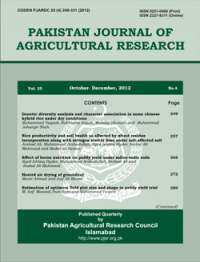EVALUATION OF LEGUME HERBS NUTRITIVE VALUE AS A RUMINANT FEED AND NITROGEN SUPPLY ON SOIL IN WEST TIMOR, INDONESIA
ABSTRACT
The four species of legumes used as ruminant feed were Clitoria ternatea (CT), Centrosema pascuorum (CP), Dolichos lablab (DL), and Macroptilium bracteatum (MB). The study was conducted in Randomized Complete Block Design. The research showed that the highest -l NO concentration after planting was in CP (5.72 mg ), followed by CT 3 -l -l -l (4.21mg ), MB (3.44 mg ), and DL (2.83 mg ). The species of legume was obviously highly significant (P<0.01) to biomass production 90 days after planting. Moreover, dry matter (DM) and organic matter (OM) in vitro digestibility were statistically different among the species of legume (P<0.01). In DL the DM and OM were highest i.e., 74.84 % and 74.37%. Meanwhile, the biomass digestibility of DM and OM was affected by the -2 treatments (P<0.01), being highest in CT (2511.4 g DMm and 2172.1 g -2 -2 -2 OMm ) followed by DL (2351.8 g DMm and 2044.9 g OMm ). Based on this study, CT and DL have potential to develop high biomass production, high digestibility, and adequately contribute NO to the soil.
To share on other social networks, click on any share button. What are these?






